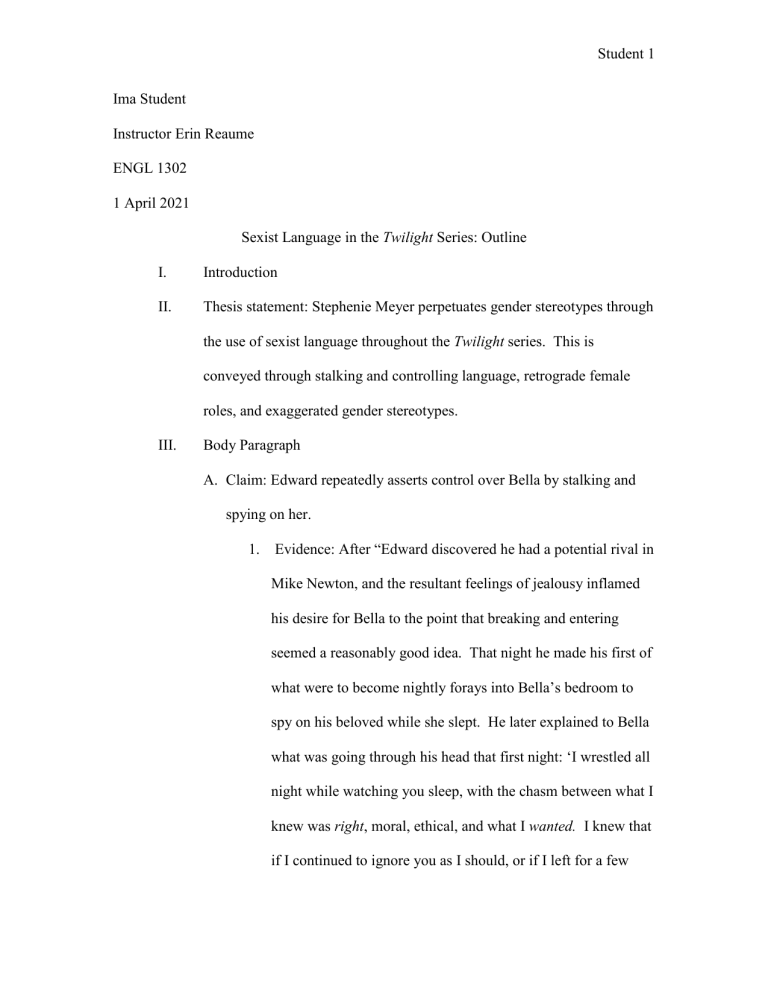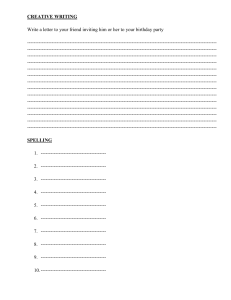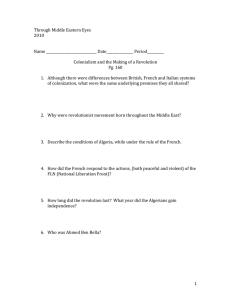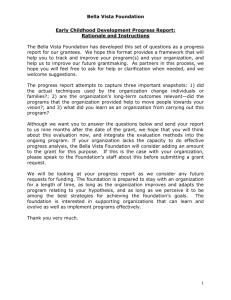
Student 1 Ima Student Instructor Erin Reaume ENGL 1302 1 April 2021 Sexist Language in the Twilight Series: Outline I. Introduction II. Thesis statement: Stephenie Meyer perpetuates gender stereotypes through the use of sexist language throughout the Twilight series. This is conveyed through stalking and controlling language, retrograde female roles, and exaggerated gender stereotypes. III. Body Paragraph A. Claim: Edward repeatedly asserts control over Bella by stalking and spying on her. 1. Evidence: After “Edward discovered he had a potential rival in Mike Newton, and the resultant feelings of jealousy inflamed his desire for Bella to the point that breaking and entering seemed a reasonably good idea. That night he made his first of what were to become nightly forays into Bella’s bedroom to spy on his beloved while she slept. He later explained to Bella what was going through his head that first night: ‘I wrestled all night while watching you sleep, with the chasm between what I knew was right, moral, ethical, and what I wanted. I knew that if I continued to ignore you as I should, or if I left for a few Student 2 years, till you were gone, that someday you would say yes to Mike, or someone like him’” (Dunn 13). 2. Evidence: Edward even has his family members spy on Bella when he is not available. For example, in New Moon, he sends his sister Alice to check up on Bella (New Moon 384). 3. Evidence: “Elizabeth Hand is representative of feminist critics when she argues in The Washington Post that ‘there's something distinctly queasy about the male-female dynamic that emerges over the series' 2,446 pages. Edward has been frozen at the age of 17. But he was born in 1901, and he doesn't behave anything like a real teenager. He talks and acts like an obsessively controlling adult male’ (7) (qtd. in Silvers 122). 4. Discussion: These ideas demonstrate that it is acceptable and even normal for a male to control his girlfriend or wife. IV. Body Paragraph A. Claim: The values that Meyer promotes seem retrograde, indeed, if we consider that Bella is depicted as a traditional 18th or 19th century 1. Evidence: “In the traditional Gothic the virgin was always under threat. It is important (but may be strictly coincidental) that the heroine of Meyer's saga is named Isabella--the name of the heroine in what is often taken to be the first true Gothic novel, Walpole's The Castle of Otranto (1764). While the Student 3 earlier Isabella is constantly besieged, the Meyer version presents a different kind of sexuality” (Nayar 70). 2. Evidence: Nayar explains how Bella behaves like the threatened teenage heroine of a Gothic novel, driving the male character near insanity with her sexuality. “Isabella consents to the pain and the threat, thus making the relationship smack of SM. Unlike the heroine of a traditional Gothic with little agency of her own, Isabella volunteers herself to Edward’s supposed brute masculinity” (Nayar 71). 3. Discussion: This evidence demonstrates that the novel uses archaic, anti-feminist language to paint the character of Bella. V. Body Paragraph A. Claim: Bella is childlike, and often represented as both physically and mentally inferior. 1. Evidence: Edward frequently refers to or treats Bella as a child. When he first met Bella, Edward tells her later, he considered her ‘an insignificant little girl’ (Twilight 271). Later he calls her ‘little coward’ (Twilight 279) and ‘Silly Bella’ (Twilight 281). 2. Evidence: “When he rescues her, Edward uses language that is more patrimonial than romantic, though clearly, Meyer blurs the two discourses. For example, after rescuing Bella from a group of would-be rapists, he tells her to ‘prattle about Student 4 something unimportant until I calm down’ (Twilight 163) and then takes her to a restaurant, where he orders her to eat and drink, his voice ‘low, but full of authority’ (Twilight 166). In response to his commands, Bella ‘sipped at [her] soda obediently’ (Twilight 169). Meyer's diction—‘prattle,’ ‘obediently’--clearly connotes a power dynamic in which Edward makes important decisions and Bella, though often grumbling and pouting, almost inevitably submits” (Silvers 125). 3. Discussion: By using this connotative language to describe Bella, Meyers shows young girls that women are inferior to men. VI. Body Paragraph A. Claim: Bella and other female characters are vocationally inferior, whereas Charlie and other male characters are depicted as domestically inferior. 1. Evidence: Bella’s father Charlie is a police chief. 2. Evidence: Edward’s father Carlisle is a skilled surgeon who saves lives. 3. Evidence: Even Bella’s stepfather, Phil, is a professional baseball player. Student 5 4. Evidence: Bella’s mother Renee is “childlike” and chooses to move to Florida with her young husband over maintaining custody of her own daughter (Twilight 4). 5. Evidence: Renee and Edward’s mother, Esme, are both essentially housewives, with no professions of their own outside the home Evidence: “Never fully recovered from his divorce to Renee, 6. Charlie has not changed the house since his ex-wife left him. The same family photographs hang on the walls, and Charlie has not learned even rudimentary cooking skills. Bella immediately takes on the domestic chores for her father, volunteering to do all the cooking and laundry, and thereby stepping into the role that her mother rejected” (Silvers 124). 7. Discussion: This language perpetuates anti-feminist stereotypes. VII. Body Paragraph A. Counterargument: Some might argue that in Bella, Stephanie Meyers creates a courageous, independent female character. B. Rebuttal: However, through Bella, Meyer demonstrates that marriage and motherhood are the highest achievements in a woman’s life. 1. Evidence While Bella is most interested in losing her virginity, Edward withholds sex from her until she agrees to Student 6 become his wife. She ultimately forgoes college, and caves into his demands. 2. Evidence: “Seifert writes that Bella becomes ‘a traditional-and boring--teenaged mom’ and that she and Edward are revealed to be ‘tepid and unenlightened people’ (24)” (qtd. in Silvers 129). 3. Discussion: Clearly, this evidence shows that while Bella may be courageous, she is not independent. VIII. Conclusion A. Call to action: Before recommending the Twilight series to adolescent readers, consider the sexist implications of these novels. B. Concluding statement: By using sexist language and gender stereotypes throughout the Twilight series, Stephenie Meyer sends a disturbing message to young girls. Student 7 Works Cited Dunn, George A. “You Look Good Enough to Eat: Love, Madness and the Food Analogy.” In William Irwin, Rebecca Housel, Jeremy Wisnewski (ed.) Twilight and Philosophy: Vampires, Vegetarians, and the Pursuit of Immortality. Wiley Blackwell, 2009. 13. Meyer, Stephenie. Twilight. Little, Brown and Company, 2005. Meyer, Stephenie. New Moon. Little, Brown and Company, 2006. Meyer, Stephenie. Eclipse. Little, Brown and Company, 2007. Meyer, Stephenie. Breaking Dawn. Little, Brown and Company, 2008. Nayar, Pramod. "How to Domesticate a Vampire: Gender, Blood Relations and Sexuality in Stephenie Meyer's Twilight." Nebula, vol. 7, no. 3, 2010, pp. 70-71. Academic OneFile, www.researchgate.net/publication/47347976_How_to_Domesticate_a_Vampire_ Gender_Blood_Relations_and_Sexuality_in_Stephenie_Meyer%27s_Twilight. Accessed 27 Mar. 2011. Silver, Anna. "Twilight is Not Good for Maidens: Gender, Sexuality, and the Family in Stephenie Meyer's Twilight Series." Studies in the Novel, vol. 42, no. 1-2, 2010, pp. 121-138. Literature Resource Center, doi: 10.1353/sdn.2010.0009. Accessed 25 Mar. 2011. Student 8


